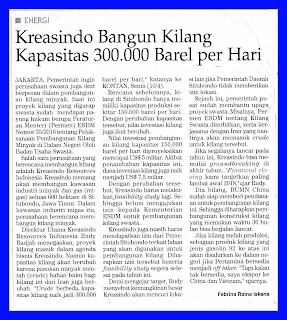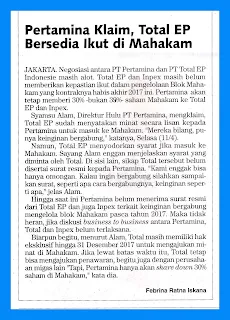The government issued the Minister of Energy and Mineral Resources (ESDM) No. 26 of 2017 regulating the investment cost recovery mechanism in the upstream oil and gas activities.
According to this rule, the investment costs are not depreciated (undepreciated cost) until the contract expires, to be borne by the new contractor. Mentioned in the Ministerial Regulation 26/2017, the issuance of this policy to maintain the fairness of the level of production and the optimization of state revenues from oil and gas upstream activities at the end of the cooperation contract (production sharing contract / PSC). This Ministerial Decree was signed by Minister Ignasius Jonan on 30 March.
Article 2 of this policy require the contractor to maintain reasonable levels of oil and gas production until the PSC ends. That is, investments in the block are the responsibility of the contractor should not stop until the end of the contract. The investment made must be in accordance with the work plan and budget (work plan and budget / WP & B) approved SKK Migas for the contract with the PSC cost recovery and work plans for contractors with gross PSC split.
As a reward beyond it, the government in Article 3 of this policy promises the contractor will get the best return of investment costs with appropriate mechanisms PSC signed. The investment cost recovery is given during the contract period. if after the contract is completed the investment cost has not been rebuilt, the government also set up a payment mechanism in this policy.
First, in terms of the PSC extended, Article 5 states that the return on investment costs can be continued for the duration of the contract for the extension of the PSC with the cost recovery scheme. Meanwhile, if extended with gross schemes split, the remaining undelivered investment costs taken into account in part of contractors. Then if there is a new contractor in addition to the existing contractor, the contractor recently also bear the undepreciated cost proportionally to the amount of participation rights (participating interest / PI) owned.
Second, when the PSC is not extended, Article 6 states that the return on investment is not depreciated cost is to be borne by the new contractor. "In the event Cooperation Contract not renewed and there are still investment costs have not been returned, the return to the contractor carried out by the new contractor," written in the Ministerial Regulation 26 / 2017. The value is in accordance with the rest of the cost of the investment to be returned.
Furthermore, Article 8 states, this obligation will be listed role in the determination letter and the management of the new PSC. The paid value will be used as a deduction from the operating costs of the existing contractor. Then the value of completed investment returns calculated as part of the new contractor.
Then in chapter 10 is mentioned, the completion of undepreciated cost is already calculated in part the contractor and can not affect the calculation for gross proceeds to the PSC split.
Of investment costs, Article 12 states that Menteridapat assign its value by considering the economics of upstream investment activities and the recommendation SKK Migas. Ministers can also set a policy on return of investment costs has not been restored in the event there are no new contractor until the contract expires cooperation.
Not clear
When asked about this policy, President Director of PT Pertamina Hulu Energi (PHE) Mount Sardjono Hadi claimed not clearly understand the contents of the new regulations. Supposedly if undepreciated cost to be paid by the new contractor, it should be taken into account in the determination of profit sharing (split). "If you do not put the split calculation, very heavy," he said.
He claimed, for the Offshore North West Java, for example, the burden of undepreciated cost is quite large, reaching US $ 450 million. Against the investment costs have yet to return, it wants the additional split. It required the company to survive and still need.
Moreover, after the switch to gross PSC split, it did find a few things that make the results received less attractive. Some of the factors that reduce the economics of the project namely the Value Added Tax (VAT) to be borne by the contractor fully borne investment costs of participation rights granted to local governments by 10%, and the cost of renting considering a production facility in ONWJ belongs to the government because the previous contract using a cost recovery scheme.
He admits, gross split also makes the company more efficient by not more regulation comes Governance (PTK) 007 SKK Migas. However, the calculation of the efficiency gained from this suit ascertained. "So I make the estimated efficiency of 10-15%. So invest in a discount of 15%, as well as internal challange, "said Mount.
Undepreciated cost problem can occur in other oil and gas blocks were rescinded and replaced with gross schemes split contract. It includes eight oil and gas blocks that have been declared assigned to Pertamina. However, he acknowledges that the amount of undepreciated cost will not be as big as in ONWJ.
IN INDONESIAN
Undepreciated Cost Di Tanggung Kontraktor Baru
Pemerintah menerbitkan Peraturan Menteri Energi dan Sumber Daya Mineral (ESDM) No 26 Tahun 2017 yang mengatur soal mekanisme pengembalian biaya investasi pada kegiatan usaha hulu migas.
Menurut aturan ini, biaya investasi yang tidak terdepresiasi (undepreciated cost) sampai kontrak berakhir, menjadi tanggungan kontraktor baru. Dalam Peraturan Menteri 26/2017 disebutkan, penerbitan beleid ini untuk menjaga kewajaran tingkat produksi dan optimalisasi penerimaan negara dari kegiatan hulu migas pada masa akhir kontrak kerja sama (production sharing contract/ PSC). Peraturan Menteri ini diteken oleh Menteri ESDM Ignasius Jonan pada 30 Maret lalu.
Pasal 2 beleid ini mewajibkan kontraktor untuk menjaga tingkat kewajaran produksi migas sampai PSC berakhir. Artinya, investasi di blok yang menjadi tanggung jawab kontraktor tidak boleh berhenti sampai akhir kontrak. Investasi yang dilakukan harus sesuai dengan rencana kerja dan anggaran (work plan and budget/WP&B) yang disetujui SKK Migas bagi kontrak dengan PSC cost recovery dan rencana kerja bagi kontraktor dengan PSC gross split.
Sebagai imbal baliknya, pemerintah dalam Pasal 3 beleid ini menjanjikan kontraktor akan memperoleh pengembalian biaya investasi dengan mekanisme sesuai PSC yang diteken. Pengembalian biaya investasi ini diberikan selama masa kontrak. jika setelah kontrak selesai biaya investasi belum kembali seluruhnya, pemerintah juga menyiapkan mekanisme pembayarannya dalam beleid ini.
Pertama, dalam hal PSC diperpanjang, Pasal 5 menyebutkan bahwa pengembalian biaya investasi dapat dilanjutkan selama masa perpanjangan kontrak untuk PSC dengan skema cost recovery. Sementara jika diperpanjang dengan skema gross split, sisa biaya investasi yang belum dikembalikan diperhitungkan dalam bagian kontraktor. Kemudian jika terdapat kontraktor baru selain kontraktor eksisting, maka kontraktor baru ini juga turut menanggung undepreciated cost secara proporsional sesuai besaran hak partisipasi (participating interest/PI) yang dimiliki.
Kedua, ketika PSC tidak diperpanjang, Pasal 6 menyatakan bahwa pengembalian biaya investasi yang belum terdepresiasi ini menjadi tanggungan kontraktor baru. “Dalam hal Kontrak Kerja Sama tidak diperpanjang dan masih terdapat biaya investasi yang belum dikembalikan, pengembalian kepada kontraktor dilakukan oleh kontraktor baru,” demikian tertulis dalam Peraturan Menteri 26/ 2017. Nilainya sesuai dengan sisa biaya investasi yang harus dikembalikan tersebut.
Selanjutnya Pasal 8 menyebutkan, kewajiban ini akan dicantumkan dalan surat penetapan pengelolaan dan PSC baru. Nilai yang dibayarkan akan dijadikan pengurang biaya operasi kontraktor eksisting. Kemudian nilai pengembalian investasi yang diselesaikan diperhitungkan sebagai bagian kontraktor baru.
Kemudian pada Pasal 10 disebutkan, penyelesaian undepreciated cost ini sudah diperhitungkan dalam bagian kontraktor dan tidak dapat mempengaruhi perhitungan bagi hasil pada PSC gross split.
Atas biaya investasi, Pasal 12 menyatakan bahwa Menteridapat menetapkan nilainya dengan mempertimbangkan keekonomian kegiatan investasi hulu setelah mendapat rekomendasi SKK Migas. Menteri juga dapat menetapkan kebijakan atas pengembalian biaya investasi yang belum dikembalikan dalam hal tidak terdapat kontraktor baru sampai kontrak kerja sama berakhir.
Belum Jelas
Ketika ditanyai soal beleid ini, Presiden Direktur PT Pertamina Hulu Energi (PHE) Gunung Sardjono Hadi mengaku belum memahami secara jelas isi peraturan baru tersebut. Seharusnya jika undepreciated cost harus dibayar oleh kontraktor baru, maka sebaiknya diperhitungkan dalam penentuan bagi hasil (split). “Kalau tidak dimasukkan perhitungan split, sangat berat," katanya.
Dia mengaku, untuk Blok Offshore North West Java misalnya, beban undepreciated cost ini cukup besar yaitu mencapai US$ 450 juta. Terhadap adanya biaya investasi yang belum kembali ini, pihaknya menginginkan adanya tambahan split. Hal ini dibutuhkan perusahaan untuk bertahan dan tetap butuh.
Apalagi setelah berganti ke PSC gross split, pihaknya menemukan beberapa hal yang membuat bagi hasil yang diterima kurang menarik. Beberapa faktor yang mengurangi keekonomian proyek yakni Pajak Pertambahan Nilai (PPN) yang menjadi tanggungan kontraktor sepenuhnya, tanggungan biaya investasi dari hak partisipasi yang diberikan ke pemerintah daerah sebesar 10%, dan adanya biaya sewa mengingat fasilitas produksi di Blok ONWJ menjadi milik pemerintah karena kontrak sebelumnya menggunakan skema cost recovery.
Dia mengakui, gross split juga membuat perusahaan lebih efisien dengan tidak lagi berlakunya Peraturan Tata Kelola (PTK) 007 SKK Migas. Namun, perhitungan efisiensi yang diperoleh dari hal ini suit dipastikan. “Jadi saya bikin estimasi efisiensi 10-15%. Jadi investasinya di diskon 15%, ini sebagai challange internal juga,” kata Gunung.
Masalah undepreciated cost ini dapat terjadi pada blok migas lain yang diputus kontraknya dan digantikan dengan kontrak skema gross split. Ini termasuk delapan blok migas yang telah dinyatakan ditugaskan ke Pertamina. Hanya saja, diakuinya besaran undepreciated cost itu tidak akan sebesar di Blok ONWJ.
Investor Daily, Page-9, Thursday, April, 13, 2017










